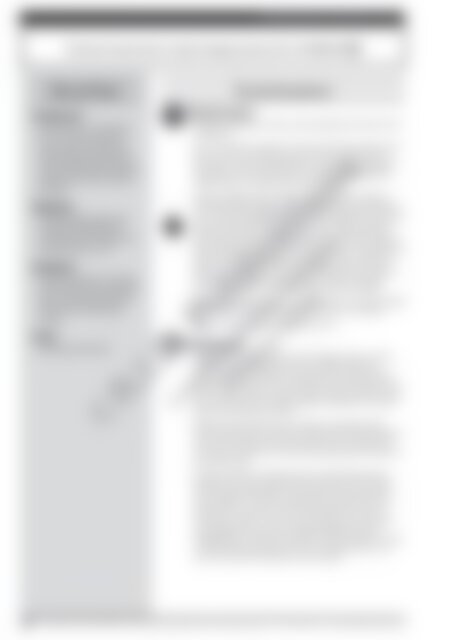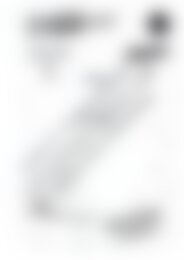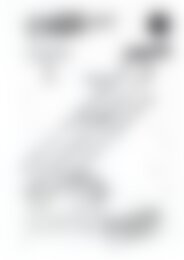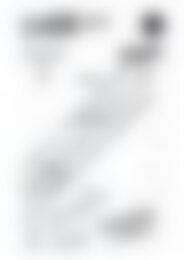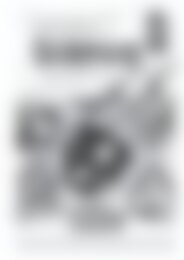RIC-20140 ACM Measurement and Geometry (Yr 2) Using units of measurement 3
You also want an ePaper? Increase the reach of your titles
YUMPU automatically turns print PDFs into web optimized ePapers that Google loves.
Sub-str<strong>and</strong>: <strong>Using</strong> <strong>units</strong> <strong>of</strong> <strong>measurement</strong>—UUM – 3<br />
Tell time to the quarter hour, using the language <strong>of</strong> ‘past’ <strong>and</strong> ‘to’ (<strong>ACM</strong>MG039)<br />
RELATED TERMS<br />
TEACHER INFORMATION<br />
Analogue clock<br />
• A clock with some or all <strong>of</strong> the digits<br />
from 1 to 12. These clocks have at<br />
least two h<strong>and</strong>s: an hour h<strong>and</strong> <strong>and</strong> a<br />
minute h<strong>and</strong>. Many analogue clocks<br />
also have another h<strong>and</strong>, a second h<strong>and</strong>,<br />
though at this year level it would not<br />
be needed.<br />
Digital clock<br />
• A clock that displays the time using<br />
only digits, with the digit for the<br />
hour separated from the digits for the<br />
minutes by a colon; e.g. 3:24.<br />
Geared clock<br />
• A model <strong>of</strong> a clock where, as one h<strong>and</strong><br />
moves, the other moves a proportional<br />
distance. Thus the h<strong>and</strong>s move in the<br />
same way that working analogue<br />
clocks do.<br />
O’clock<br />
• Literally means ‘<strong>of</strong> the clock’.<br />
What does it mean<br />
• Students need to have a basic underst<strong>and</strong>ing <strong>of</strong> the fractions half<br />
<strong>and</strong> quarter.<br />
• The use <strong>of</strong> the term ‘quarter to’ is the only time that students read<br />
times as ‘to’ the hour. When they learn to read <strong>and</strong> say times to<br />
the nearest 5 minutes <strong>and</strong> beyond, we use the digital method <strong>of</strong><br />
saying times such as ‘three forty’ or ‘six thirty-eight’, rather than<br />
‘twenty to four’ or ‘twenty-two minutes to seven’.<br />
• <strong>Using</strong> an analogue clock, students recognise that at 12:00, the<br />
minute (big) h<strong>and</strong> <strong>and</strong> the hour (small) h<strong>and</strong> are both pointing to<br />
the 12. At any other o’clock time, the hour h<strong>and</strong> points to the hour,<br />
<strong>and</strong> the minute h<strong>and</strong> points to the 12. Also, students recognise<br />
that when the time is ‘half past’ the hour, the big h<strong>and</strong> points to<br />
the 6 <strong>and</strong> the small h<strong>and</strong> points halfway between two numbers on<br />
the dial; that when the time is ‘quarter past’ the hour, the big h<strong>and</strong><br />
points to the 3 <strong>and</strong> the small h<strong>and</strong> points a quarter <strong>of</strong> the way<br />
between two numbers on the face; <strong>and</strong> when the time is ‘quarter<br />
to’ the hour, the big h<strong>and</strong> points to the 9, <strong>and</strong> the small h<strong>and</strong><br />
points three-quarters <strong>of</strong> the way between the two numbers.<br />
• Students underst<strong>and</strong> that there are 60 minutes in an hour, that half<br />
an hour is 30 minutes <strong>and</strong> a quarter <strong>of</strong> an hour is 15 minutes.<br />
• Students should be able to count by 5s to 60.<br />
Teaching points<br />
• Students recognise the features <strong>of</strong> an analogue clock: it is <strong>of</strong>ten<br />
circular; has a small h<strong>and</strong> for the hour, a large h<strong>and</strong> for the<br />
minutes, <strong>and</strong> many analogue clocks also have a longer, thinner<br />
h<strong>and</strong> for the seconds; the 12 is located at the top <strong>of</strong> the clock, the<br />
6 at the bottom <strong>and</strong> the 3 <strong>and</strong> 9 on either side. For students <strong>of</strong> this<br />
age, a clock that shows all twelve digits is preferable. Try to avoid<br />
clocks that use Roman numerals.<br />
©R.I.C. Publications<br />
Low Resolution Images<br />
Display Copy<br />
• Students recognise that the hour h<strong>and</strong> on an analogue clock<br />
travels slowly <strong>and</strong> its movement cannot be seen; the minute h<strong>and</strong><br />
travels more quickly <strong>and</strong> can sometimes be seen moving; if the<br />
clock has a second h<strong>and</strong>, it moves quite quickly <strong>and</strong> its movement<br />
can easily be seen.<br />
• If using a model <strong>of</strong> an analogue clock, it is preferable to have a<br />
geared clock, so that as the minute h<strong>and</strong> moves, the hour h<strong>and</strong><br />
moves a proportional distance. This means that when the time<br />
is, for example, 7:15, the hour h<strong>and</strong> will be a quarter <strong>of</strong> the way<br />
between the 7 <strong>and</strong> the 8. As the minute h<strong>and</strong> on the clock is<br />
moved from 7:00 to 7:15, the hour h<strong>and</strong> slowly moves too. With<br />
a non-geared clock, the hour <strong>and</strong> minute h<strong>and</strong>s are moved<br />
independently, so as the minute h<strong>and</strong> is moved from the 12 to the<br />
3 to show quarter past the hour times, the hour h<strong>and</strong> does not<br />
move. This may be confusing for some students.<br />
26 Australian Curriculum Mathematics resource book: <strong>Measurement</strong> <strong>and</strong> <strong>Geometry</strong> (Year 2) R.I.C. Publications ® www.ricpublications.com.au


